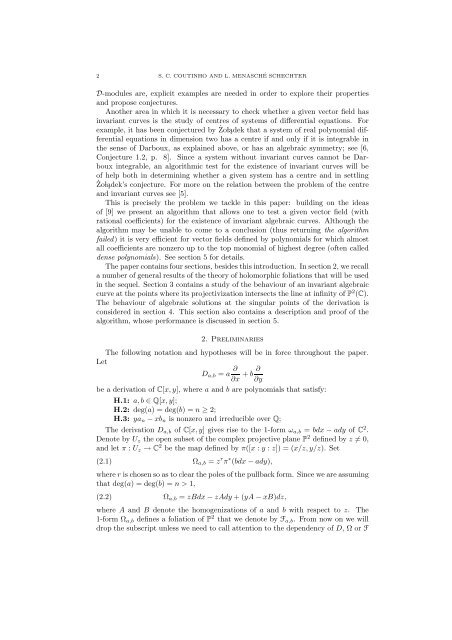ALGEBRAIC SOLUTIONS OF PLANE VECTOR FIELDS ... - dCC-UFRJ
ALGEBRAIC SOLUTIONS OF PLANE VECTOR FIELDS ... - dCC-UFRJ
ALGEBRAIC SOLUTIONS OF PLANE VECTOR FIELDS ... - dCC-UFRJ
You also want an ePaper? Increase the reach of your titles
YUMPU automatically turns print PDFs into web optimized ePapers that Google loves.
2 S. C. COUTINHO AND L. MENASCHÉ SCHECHTER<br />
D-modules are, explicit examples are needed in order to explore their properties<br />
and propose conjectures.<br />
Another area in which it is necessary to check whether a given vector field has<br />
invariant curves is the study of centres of systems of differential equations. For<br />
example, it has been conjectured by ˙ Zo̷l¸adek that a system of real polynomial differential<br />
equations in dimension two has a centre if and only if it is integrable in<br />
the sense of Darboux, as explained above, or has an algebraic symmetry; see [6,<br />
Conjecture 1.2, p. 8]. Since a system without invariant curves cannot be Darboux<br />
integrable, an algorithmic test for the existence of invariant curves will be<br />
of help both in determining whether a given system has a centre and in settling<br />
˙Zo̷l¸adek’s conjecture. For more on the relation between the problem of the centre<br />
and invariant curves see [5].<br />
This is precisely the problem we tackle in this paper: building on the ideas<br />
of [9] we present an algorithm that allows one to test a given vector field (with<br />
rational coefficients) for the existence of invariant algebraic curves. Although the<br />
algorithm may be unable to come to a conclusion (thus returning the algorithm<br />
failed) it is very efficient for vector fields defined by polynomials for which almost<br />
all coefficients are nonzero up to the top monomial of highest degree (often called<br />
dense polynomials). See section 5 for details.<br />
The paper contains four sections, besides this introduction. In section 2, we recall<br />
a number of general results of the theory of holomorphic foliations that will be used<br />
in the sequel. Section 3 contains a study of the behaviour of an invariant algebraic<br />
curve at the points where its projectivization intersects the line at infinity of P 2 (C).<br />
The behaviour of algebraic solutions at the singular points of the derivation is<br />
considered in section 4. This section also contains a description and proof of the<br />
algorithm, whose performance is discussed in section 5.<br />
2. Preliminaries<br />
The following notation and hypotheses will be in force throughout the paper.<br />
Let<br />
Da,b = a ∂ ∂<br />
+ b<br />
∂x ∂y<br />
be a derivation of C[x, y], where a and b are polynomials that satisfy:<br />
H.1: a, b ∈ Q[x, y];<br />
H.2: deg(a) = deg(b) = n ≥ 2;<br />
H.3: yan − xbn is nonzero and irreducible over Q;<br />
The derivation Da,b of C[x, y] gives rise to the 1-form ωa,b = bdx − ady of C 2 .<br />
Denote by Uz the open subset of the complex projective plane P 2 defined by z = 0,<br />
and let π : Uz → C 2 be the map defined by π([x : y : z]) = (x/z, y/z). Set<br />
(2.1) Ωa,b = z r π ∗ (bdx − ady),<br />
where r is chosen so as to clear the poles of the pullback form. Since we are assuming<br />
that deg(a) = deg(b) = n > 1,<br />
(2.2)<br />
Ωa,b = zBdx − zAdy + (yA − xB)dz,<br />
where A and B denote the homogenizations of a and b with respect to z. The<br />
1-form Ωa,b defines a foliation of P 2 that we denote by Fa,b. From now on we will<br />
drop the subscript unless we need to call attention to the dependency of D, Ω or F
















